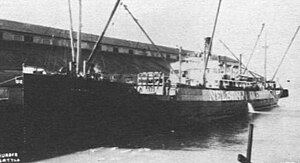USAT Arcata
 SS Glymont
| |
| History | |
|---|---|
| Name |
|
| Owner |
|
| Builder | Albina Engine & Machine Works, Portland, Oregon |
| Cost | $821,751.56 |
| Launched | 23 April 1919 |
| Completed | 1919 as Glymont |
| Acquired | Chartered by the US Army as USAT Arcata |
| Identification | U.S. Official Number: 217972 |
| Fate | Sank in 1942 off Alaska |
| General characteristics [1][2][3] | |
| Type | Design 1049 "Albinia Type" cargo ship |
| Tonnage | 2,254 GRT, 1,353 NRT, 3,700 DWT |
| Displacement | 5,070 tons |
| Length |
|
| Beam | 44.1 ft (13.4 m) |
| Draft | 17 ft 11 in (5.5 m) |
| Depth | 19.2 ft (5.9 m) |
| Propulsion | Triple expansion steam, single propeller |
| Speed | 12 knots |
| Boats & landing craft carried | 2 |

USAT Arcata, was built in 1919 as the SS Glymont for the United States Shipping Board as a merchant ship by the Albina Engine & Machine Works in Portland, Oregon. The 2,722-ton cargo ship Glymont was operated by the Matson Navigation till 1923 in post World War I work.[4] In 1923 she was sold to Cook C. W. of San Francisco. In 1925 she was sold to Nelson Charles Company of San Francisco. In 1937 she was sold to Hammond Lumber Company of Fairhaven, California. For World War II, in 1941, she was converted to a US Army Troopship, USAT Arcata. She took supplies and troops to Guam.[5] On July 14, 1942, she was attacked by Japanese submarine I-7 and sank. She was operating as a coastal resupply in the Gulf of Alaska, south of the Aleutian Islands at (53°41′N 157°45′W / 53.683°N 157.750°W), approximately 165 nautical miles (306 km; 190 mi) southeast of Sand Point, when she sank. She was returning after taking supplies to Army troops fighting in the Aleutian Islands campaign.[6]
SS Glymont[edit]
Glymont was an Emergency Fleet Corporation design 1049 cargo ship, delivered in May 1919 to the United States Shipping Board. Her hull number was 14 and United States Shipping Board #1691, her official ship number was 217972. In the 1920 and 1930 as the SS Glymont, traveled to ports in China, Hawaii, San Pedro, Seattle, Vancouver Hong Kong, Ichang Chungking Tientsin Manila Kobe and Singapore. In 1921 she was sold to the Robert Dollar Company and used on the same routes.[7]
Construction[edit]
Glymont was built in 1919 by Albina Engine & Machine Works, Portland, Oregon. The designation Emergency Fleet Corporation (EFC) Design 1049 "Albinia Type" ship was applied to an existing Albina design after the United States Shipping Board (USSB) requisitioned the ships. The hull was Albina's yard hull number 14, USSB/EFC hull number 1691.[1][2][8][9]
The type was 2,254 GRT, 1,353 NRT, 3,700 DWT, 289 ft (88.1 m) in registry length, 44.1 ft (13.4 m) beam and 19.2 ft (5.9 m) draft. The ship was oil fired with triple expansion steam engines.[1][2]
Sinking[edit]
On July 14, 1942, the USAT Arcata was attacked with the deck gun and machine guns of Japanese Submarine I-7. The Arcata was not carrying any troops when attacked. She had a crew of 29 and four passengers. The four passengers were three US Navy personnel and one civilian. When attacked she was traveling from Bethel, Alaska to Seattle, Washington. One of the submarine's deck gun shells hit the bridge and killed one sailor. The captain gave the abandon ship order, the ship was unarmed. The crew and passengers loaded into lifeboats. The submarine machine gunned the lifeboats, injuring more crew. The lifeboat drifted in the Bering Sea. Some of the crew died of exposure and hypothermia.[2][10][11][12][13] The USS Kane (DD-235) found one of the lifeboats and rescued eleven survivors of the SS Arcata. An Alaskan fishing boat Yukon found and picked up the other lifeboat with fourteen survivors. In the end eight died, two crew killed from the attack, six from exposure and four passengers survived.[14][15]
References[edit]
- ^ a b c Fifty-Third Annual List of Merchant Vessels of the United States, Year ended June 30, 1921. Washington, D.C.: Department of Commerce and Labor, Bureau of Navigation. 1921. p. 137. Retrieved 22 May 2021.
- ^ a b c d McKellar, Norman L. "Steel Shipbuilding under the U. S. Shipping Board, 1917-1921, Requisitioned Steel Ships, Part VII" (PDF). Steel Shipbuilding under the U. S. Shipping Board, 1917-1921. ShipScribe. p. 320a. Retrieved 22 May 2021.
- ^ Naval History And Heritage Command (March 11, 2018). "Majaba (AG-43)". Dictionary of American Naval Fighting Ships. Naval History And Heritage Command. Retrieved 22 May 2021.
- ^ Baltimore, Volumes 13-14, page 22, October 1919
- ^ Submerged Cultural Resources Assessment of Micronesia, By Toni Carrell
- ^ wrecksite.eu SS Arcata
- ^ "General Cargo Ships Built in Pacific Coast Shipyards".
- ^ "EFC Design 1049: Illustrations". ShipScribe. Retrieved 23 May 2021.
- ^ Colton, Tim (October 7, 2020). "Albina Engine & Machine Works, Portland OR". ShipbuildingHistory. Retrieved 22 May 2021.
- ^ "EFC Design 1049: Illustrations". ShipScribe. Retrieved 26 May 2021.
- ^ Maritime Administration. "Arcata". Ship History Database Vessel Status Card. U.S. Department of Transportation, Maritime Administration. Retrieved 26 May 2021.
- ^ alaskashipwreck.com Alaska Shipwrecks (A)
- ^ "SS Albertolite". Ian Ferguson. Retrieved 17 January 2012.
- ^ Hocking, Charles, Dictionary of Disasters at Sea during the Age of Steam
- ^ "The Thousand Mile War" by Brian Garfield, page 131
